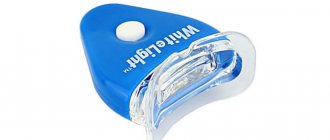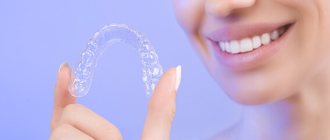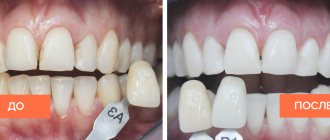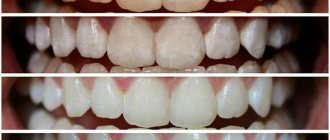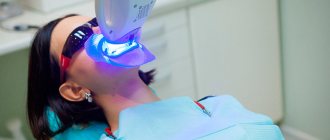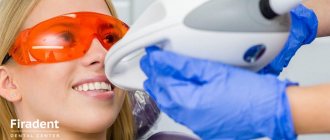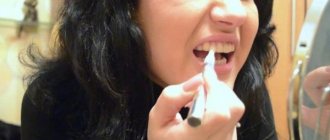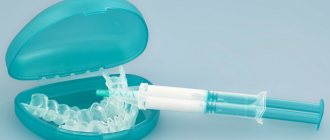From this article you will learn:
- before and after photos,
- teeth whitening Zoom – price 2021.
The article was written by a dentist with more than 19 years of experience.
Teeth whitening ZOOM 4 is one of the professional whitening methods that is carried out in a dental office. The active substance used is 25% hydrogen peroxide gel - in combination with a special “Zoom WhiteSpeed” lamp (Fig. 1-2), which, according to the manufacturer, increases the strength and speed of whitening.
Zoom whitening was developed by the American company DISCUS DENTAL, but LED lamps for it are produced by Philips (the Netherlands). Zoom 4 is already the fourth generation of this system, and before that Zoom, Zoom 2 and Zoom 3 were released in turn. At the moment, only the 3rd and 4th generations of this system are used, which (compared to the previous ones) have become much safer for teeth.
Zoom-4 lamp and whitening kit –
In general, only about 55% of patients have positive reviews of Zoom 4 whitening, and below we will go into detail about the reasons for the negative reviews. For example, the manufacturer’s claimed whitening of teeth by 8 shades in 1 procedure, which lasts for 3-5 years, is more of an advertising ploy. The fact is that the degree of teeth whitening is assessed by the dentist immediately after the whitening procedure, and not a few days later.
But due to exposure to intense light flux, as well as prolonged isolation of teeth from the moist environment of the oral cavity during the procedure, the enamel of the teeth loses moisture, and due to the dryness of the enamel, the teeth initially look much whiter. Within 24 hours, the saturation of the enamel with water will be completely restored, and you will be able to notice that the color of your teeth will no longer be as white as it was immediately after the procedure. But this is not the only problem with the Zoom 3 and 4 systems...
How does Zoom 4 teeth whitening work –
Teeth whitening with the Zoom 4 system is achieved through the simultaneous action of 2 components. The main component of the system is a whitening gel, which contains a 25% concentration of hydrogen peroxide, as well as a special photosensitive activator. The latter accelerates the decomposition of hydrogen peroxide into free radicals when exposed to a light flux of a certain wavelength.
The second component of the Zoom 4 system is the Zoom WhiteSpeed lamp. This is an LED lamp that emits light with a wavelength in the range of 400-505 nanometers. The light flux, acting on the whitening gel applied to the front surface of the teeth, accelerates the decomposition of hydrogen peroxide in it. As a result of this process, free radicals are formed that penetrate the dental tissues, destroying pigment molecules there.
A high 25% concentration of whitening gel + additional exposure to a light source allows you to achieve whitening results of up to 6-8 tones* in just 1 procedure. The duration of the procedure will be only 60 minutes. Whitening stages are carried out three times in a row for 15 minutes, during which new portions of the whitening gel will be applied and the LED lamp will turn on. And at the very end, you will be given an application of remineralizing gel to reduce the adverse effects of whitening on tooth tissue.
Brief and complete video of the Zoom whitening process –
Teeth whitening Zoom 3 and 4: differences
Dental clinics now offer Zoom whitening, which can be performed using either a 3rd or 4th generation LED lamp. Teeth whitening Zoom 3 involves the use of a Zoom Advanced Power lamp (Fig. 5), and teeth whitening Zoom 4 uses a Zoom WhiteSpeed lamp (Fig. 4). The latter has a higher intensity of light flux, as well as the ability to adjust the light intensity during the procedure.
Such characteristics of the WhiteSpeed lamp can reduce the risk of a patient developing pain syndrome (increased sensitivity of teeth), or reduce its intensity. By the way, it should be noted that for Zoom 3 and 4, a whitening gel of the same composition and characteristics is used. Thus, the difference between them lies solely in the functionality of the lamp itself.
Both lamps look almost the same -
Important: an interesting point is that, unlike all other whitening systems, Zoom lamps emit light in the ultraviolet range. The fact is that ultraviolet light itself has a slight bleaching effect. However, other manufacturers of similar whitening systems especially emphasize that their whitening lamps are equipped with a 100% ultraviolet filtration system to avoid negative effects on the oral mucosa (24stoma.ru).
The manufacturer Zoom claims that its lamps have filters that remove all the negative part of the ultraviolet spectrum and produce only safe ultraviolet light. But how true this is and whether this can lead to the development or worsening of diseases of the mucous membrane (for example, leukoplakia) - one can only guess. And therefore, in our opinion, the use of Zoom can be dangerous for smokers, who are already at risk for the development of precancerous diseases of the oral mucosa and the red border of the lips.
Save the result
The crystalline structure of hard tissues after bleaching is vulnerable and open to attack.
In the first week, you should stop smoking and eat foods without natural or artificial colors. Pigmenting agents can work in the opposite direction when an unwanted tone appears.
You should not eat hot and cold foods at the same time. This can negatively affect the enamel weakened after the procedure. In order for the effect to last as long as possible, you need to contact your dentist for professional plaque removal, as well as carry out daily oral care at home.
To restore teeth, use:
- special pastes with a strengthening effect;
- night guards with medicinal products;
- Rinse your mouth every time after eating.
Zoom teeth whitening: price
The cost for Zoom teeth whitening in 2021 will be about 15,000 rubles in mid-price clinics. Moreover, the cost will not depend on the generation of the whitening lamp. And in any case, Zoom 3-4 generations will use the same version of the clinical whitening kit, which will contain 25% whitening gel and many different devices.
There are 2 options for sets (Fig. 6). The first option is Zoom CH Single Kit, which is an individual kit for 1 patient; its cost is about 10,000 rubles. The second option is a set for 2 patients, the cost of which will be about 17,000 rubles. Therefore, when they offer you Zoom whitening costing 8,000 rubles, it will probably be a scam. In this case, most likely, whitening gel and consumables from a cheaper manufacturer will be used, or even fake “Zoom” kits from Chinese manufacturers.
The maximum price for Zoom whitening in Moscow reaches 30,000 rubles. When you decide whether to buy this procedure or not, keep in mind that after the procedure in the clinic, you will still have to additionally buy home teeth whitening Zoom (Fig. 7). This set is designed to support results and is available in two versions: Zoom “Nite White” or “Day White”.
These kits contain whitening gel for use at home. Only the purchase price (cost price) of such kits for maintenance therapy will be about 8,500 rubles, but in the clinic you can only buy them with a corresponding additional markup. Therefore, consider what the final price for Zoom whitening will be...
Is there any harm
Dentists say that Zoom 3 technology is completely safe for health. However, if the patient comes for the procedure again, then problems with the strength of the enamel may occur.
The result and safety depend on the clinic and its specialists. Before starting whitening, you should inquire about the availability of an official certificate issued for working with Zoom technology.
This precaution will let you know whether you have contacted a knowledgeable doctor and whether the equipment is in good condition. Without this certificate, patients risk harming their health.
Advantages of professional whitening Zoom 4 –
The main advantage of professional whitening systems at the dentist is the high speed of achieving results. But, as for the effectiveness of whitening, many modern products for use at home (whitening strips, as well as special home kits consisting of aligners and gel) are no less effective at the moment, but still require significantly longer duration of use.
According to the manufacturer, Zoom 4 whitening has the following advantages (some of which are quite controversial and we will also comment on them below)…
- you only need 1 visit to the dentist,
- whitening up to 8 shades,
- the whitening result lasts for 3-5 years,
- The procedure lasts only 1 hour,
- the concentration of hydrogen peroxide is only 25%, which is 10% lower than in similar professional whitening products from other manufacturers (this reduces the severity of side effects),
- the whitening gel has a pH from 7.5 to 8.5 (does not cause pronounced demineralization of dental tissues),
- The whitening gel contains components that strengthen the enamel and reduce tooth sensitivity.
Below we will show you “before and after” photos of patients, and also tell you why reviews of teeth whitening with the Zoom system (with all the advantages listed above) are only positive for about 55% of patients.
Brief description of the technique
The Zoom technique was developed in the United States and then began to be used in most countries of the world. The process of restoring teeth whiteness is based on the application of a gel containing carbamide and hydrogen peroxide.
The chemical composition is distributed over 10 lower and 10 upper teeth. A Zoom curing lamp is used to activate the chemicals. Its beam helps the gel components penetrate the pores of the enamel and lighten it.
The result is noticeable immediately after the procedure. Chemical exposure can be traumatic for teeth, so it is necessary to contact a dentist with the appropriate skills and experience.
Zoom: before and after photos
Reading reviews of Zoom teeth whitening (which we will also present later in this article) you will see that many patients note a good effect from the procedure only if the teeth were initially quite yellow. In this case, the “before and after” effect of whitening is visible quite well. If you want to make already quite light teeth whiter, the effect will be practically unnoticeable.
Teeth whitening Zoom-4: before and after photos
Indications
This procedure is suitable for almost everyone, since the gel substances are non-toxic. Whitening using the Zoom technique is indicated in the following cases:
- the enamel has a gray or yellow tint;
- teeth have acquired a dark color due to smoking or frequent consumption of foods with dyes;
- the enamel received an unaesthetic color after treatment with tetracycline antibiotics;
- teeth are unevenly colored.
Find out the principle of action of Corega cream for fixing dentures, and detailed instructions for its use. Read here about the features of Swiss Straumann implants.
At this address we offer detailed information about the treatment of chronic osteomyelitis of the jaw.
Teeth whitening Zoom 4: reviews
As we said at the beginning of the article, only about 55% of patients were satisfied with Zoom whitening for its fast and good results. However, the remaining patients regretted their choice and said that they would never undergo this procedure again and would not be able to recommend it to anyone. Let's figure out what this was connected with (all reviews are unique and taken from the site https://www.realself.com/zoom-teeth-whitening/patient-reviews).
Severe shooting pains in teeth -
Reviews of Zoom whitening from people with hypersensitive teeth usually contain complaints of sharp shooting pains in the teeth, which can occur both during the whitening procedure and for several days after its completion. However, many patients who have never previously suffered from hypersensitivity also report the appearance of severe pain.
Reviews describe many cases where patients had to ask the doctor to interrupt the procedure due to unbearable pain. In this case, the lamp was turned off, and the whitening gel was immediately washed off from the teeth. Patients were prescribed strong analgesics and applications with enamel-strengthening gels. Despite the fact that we present negative reviews below (because this will allow you to understand what you may encounter) - we objectively recognize that 55% of patients were satisfied with Zoom.
Examples of reviews –
- Reviewed January 26, 2021 “Within an hour I began to experience terrible shooting pains that lasted up to 30 seconds each time.
I had to leave my job. By the time I returned home, I had constant pain in all my teeth. I moaned and rolled on the sofa until the evening, and in the evening I went to the dentist's office. The doctor rubbed some kind of anesthetic gel into my teeth and prescribed a strong painkiller. But the pain did not disappear, I did not sleep all night. The pain went away only after 16 hours. Seriously, if your teeth have even the slightest sensitivity - I would not recommend this ever. It was the most painful procedure of my life. My experience may not be everyone's experience, but for me it was terrible. So I wanted to warn people so they don't experience the same thing I did."
- Reviewed June 10, 2021 “Let me start by saying, you can't even imagine the pain that comes with Zoom. Before the procedure, the dentist's exact words were: "you may feel a little sensitivity in 1-2 teeth." This didn't bother me because I don't have sensitive teeth. The first 10 minutes of the procedure went without any worries. But over the next 30 minutes there were terrible stabbing sharp pains in each tooth. It is as if the nerves were exposed to an electrical current. Yes, my teeth are several shades whiter, but I will never repeat this procedure or recommend it to anyone.”
- Reviewed February 18, 2021 “6 hours later I am still in a lot of pain and the painkiller Advil isn't even helping. I can't eat anything, take a sip of water or even talk. This is terrible, I will never do this procedure again. Yes, my teeth look whiter, but it's not worth the pain I'm going through."
- Reviewed October 3, 2021 “The pain started about 10 minutes after the end of the session. At first it was mild, but after a couple of hours I was in bed, drinking a strong painkiller. I can't work because I can't even talk. Air entering through my mouth when I speak causes severe pain. I tried to suck the bread and even that caused pain. I'm so upset, it's killing me! I wouldn't recommend it to anyone! I can imagine how harmful this procedure is for my teeth if they react this way. Save your money and yourself!”
- Review January 30, 2014 “I went for my regular checkup and the dentist said my teeth were perfect for whitening.
I had noticed yellowing of my teeth before, but had never had professional whitening done. They told me that “there would be some tooth sensitivity,” but I was not prepared for the absolute excruciating pain that I experienced already during the procedure, and it only got worse from there. 10 minutes after the start of the procedure, I experienced the first severe shooting pains. By the end of the whole procedure, my eyes were full of tears. The doctor coated my teeth with fluoride and gave me ibuprofen, but none of that worked. I can't eat or even move my mouth because... any touch of the teeth causes excruciating pain in them. I can't stop crying even though I left the clinic two hours ago. My teeth have never been this sensitive, so it's not just my body overreacting. I wish I had used whitening strips or something else. If you think you may have even the slightest tooth sensitivity, the strips will work infinitely better and cause far less pain than the Zoom procedure."
Conclusions: you should not undergo a professional whitening procedure in principle if you periodically experience pain in your teeth due to thermal and mechanical stimuli (i.e., there is increased sensitivity of the teeth). In other cases, the risk of developing acute pain will be significantly lower. Zoom-4 uses the latest generation of WhiteSpeed lamp, which allows during the procedure, if necessary, to reduce the intensity of the light flux, which somewhat reduces the severity of pain.
The degree of whitening may be lower than expected -
As we said above: teeth lightening by 6-8 shades in 1 Zoom procedure is not very true.
The dentist will measure your teeth color using a special scale (for example, Vita or others) - before and immediately after the whitening procedure. The problem is that teeth lose a lot of moisture during whitening, and overdried teeth always look whiter. Therefore, when the dentist shows you the change in tooth color immediately after the procedure, you should know that the resulting tooth color will change within 1-2 days. This will happen because the hard tissues of the teeth, overdried during the procedure, will gradually become saturated with moisture, which will lead to a decrease in the degree of whiteness of the teeth obtained immediately after the Zoom whitening procedure.
Determining the shade of teeth using a special scale -
If your dentist insists on guaranteeing that your teeth will be 6 or 8 shades lighter, then ask him to measure the color of your teeth not immediately after the procedure, but the next day, and ask him to include this clause in the contract for the possibility of a refund. Believe me, the dentist’s mood will immediately change... You can get a fairly good result only if your teeth are really yellow. If your teeth are already quite light, but you want to make them even whiter, keep in mind that the visible effect obtained immediately after the procedure will be practically unnoticeable after 1-2 days.
Examples of reviews –
- Reviewed December 27, 2021 “I had Zoom teeth whitening twice because... the first time my teeth looked no better. My teeth didn't look like the ones in the Zoom commercial. My before and after photos look almost identical (this was after the first time, but even after I did it the second time - the results were about the same). It’s not worth the cost and it’s not worth the pain I’ve endured.”
- Reviewed June 11, 2015 “Unless you have super yellow teeth, you won't notice a significant difference. Unless the whitening doctor only treats half of your teeth so you can compare the difference. Don’t be fooled by doctors who will guarantee you super results, because... They themselves cannot predict what the effect of whitening will be on each individual patient.”
Why the effect may not last long -
Although dentists claim that Zoom teeth whitening can give results for 3-5 years, this is basically advertising again. The problem with quickly lightening teeth in 1 procedure is the high rate of “rebound” of tooth color. And there is a dependence: the shorter the procedure, the faster your natural teeth color returns. That is why with whitening systems, which involve daily procedures for 30-60 minutes for 10-20 days, the achieved effect lasts longer.
And that is why the manufacturer Zoom also produces home whitening systems, the regular periodic use of which is necessary to maintain the result. And immediately after the procedure, the dentist will always recommend that you buy such a home support system Zoom. As a result, the final cost of Zoom whitening will be 5-6 times higher when compared with high-quality home whitening systems such as “Opalescens”.
A 2013 publication by Basson, which reviewed the results of 49 clinical studies conducted from 1998 to 2011, states that professional whitening achieves initial improvement in tooth color—only slightly better than at-home whitening systems. Moreover, when measuring the color of teeth 4 weeks after the end of the whitening procedure, professional whitening showed a significantly greater relapse of tooth color (compared to home whitening).
Examples of reviews –
- Reviewed August 27, 2013 “A few weeks before getting veneers, I had a Zoom teeth whitening treatment as recommended by my dentist. I didn't feel anything during the treatment, but an hour after leaving the clinic I began to experience excruciating pain that lasted for about eight hours. Although my teeth became significantly whiter - this whiteness faded within 1 month. Now more than 4 months have passed since the treatment, and I can hardly see the difference between “before” and now. I will no longer undergo this procedure because I believe that it is not worth the pain and the cost.”
- Review dated April 20, 2014 “The result obtained is not worth a penny. So, the almost invisible effect of Zoom disappeared after 2 days. I had better results even after using regular at-home whitening strips. In general - never again, a waste of money."
Risk of chemical burn to gums –
Before a whitening procedure, your dentist will always place what is called a “liquid rubber dam” on your gums, which is supposed to seal off 25% of the hydrogen peroxide from your gums. Sometimes dentists do not properly isolate the gums and lips from contact with the whitening gel, which leads to the development of a chemical burn. The problem is that scarring of the gums and lowering of its level can occur, exposing the surface of the tooth root.
What does a gum burn look like after Zoom?
Review example –
- Reviewed February 3, 2021 “The day after the procedure, the entire inside of my lower lip was white and very sore. It looks like my entire bottom lip was burned off by the hydrogen peroxide. I can't drink hot drinks, eat anything spicy, or brush my teeth because they all cause severe pain when they touch my lips and gums. Due to the fact that I can’t brush my teeth, they are no longer so white. I wish I had never done this."
Negative effects on tooth tissue –
If they tell you that professional whitening does not lead to demineralization of dental tissues (loss of calcium), then you should not believe it. Clinical studies "Sighiand Denry" (1992), "McCracken et al." (1996) showed that chemical bleaching leads to a decrease in enamel strength and wear resistance to abrasives and chemicals. And the higher the concentration of hydrogen peroxide is used, the higher the degree of demineralization of enamel and dentin.
That is why the manufacturing company Zoom recommends that all patients undergo remineralization therapy not only after the whitening procedure, but also before it begins. In addition, the contraindications to Zoom include a group of patients with weak resistance of tooth enamel to acids and mechanical stress (i.e., patients with weak mineralization of tooth enamel), which once again confirms that whitening has a negative effect on the hard tissues of teeth.
Review example –
- Reviewed October 16, 2014 “I have always had white teeth, but I wanted them to be even whiter. So I did Zoom. It was the worst experience. I have never had tooth decay or gum disease. I had severe pain after the procedure. But the most important thing is different... I began to notice that the enamel began to collapse (peel off) from the front surface of my teeth.”
Commentary on the review - if a dentist recommends a whitening procedure for a patient with weak enamel mineralization, then destruction of its surface layer is indeed possible. To reduce the risk of tooth decay, teeth are treated with “Relief” gel based on amorphous calcium phosphate before and after Zoom. The use of a gel is an attempt to compensate for the negative effects of whitening on tooth tissue, which will certainly reduce the negative effects of exposure to high concentrations of hydrogen peroxide on tooth tissue.
Pay attention to the following before and after photo (Fig. 17). If you look closely, in the first photo taken before the Zoom procedure, there are white chalky spots on the teeth. Such stains indicate insufficient mineralization of tooth enamel, and as a result, poor resistance to chemical and mechanical factors. Because The dentist neglected the rules for selecting patients for this procedure - the patient received not only uneven tooth color, but also a predisposition to the development of caries and increased enamel abrasion.
Increases the risk of fillings falling out –
Clinical studies by Della Bona et al. 1992, Tiunsakeretall 1990, Titleyetall 1991 - showed that chemical bleaching with hydrogen peroxide disrupts the bond between tooth dentin and filling materials (both light composites and glass ionomer cements). As a result, the marginal fit of the filling to the tooth tissue deteriorates, which can lead to the development of caries at the filling/tooth interface and loss of fillings.
How does light affect the effectiveness of whitening?
Not all, but many professional teeth whitening systems recommend using light during the procedure, and Zoom is no exception. For many years, there has been debate in the dental community about whether light activation actually speeds up and improves the teeth whitening process. So why do we need light here at all?
According to the technology, the light flux activates a chemical photocatalyst in the whitening gel, which helps break down hydrogen peroxide into active components (free radicals). This increases the concentration of active radicals that simultaneously act on tooth tissue, which in theory should increase the strength of whitening. Most scientific publications on this topic are not independent, and are financed by the manufacturers of such systems themselves.
But there are also several independent studies that use the most objective approach to assessing results, called “split arch”. Using this method, each patient's teeth are divided into halves: on the left half of the jaws the same type of whitening is performed with light, and on the right half - without light. Next, the results are compared. This method is the gold standard for evaluating whitening methods because... here different methods are compared on the teeth of one person, and not on different people (whose teeth may respond differently to whitening).
List of scientific studies (showing that the use of light does not affect the effectiveness of whitening) –
- Hein 2003 This study used the split-arch method to evaluate the effectiveness of 3 professional bleach systems (LumaArch, Optilux 500 and Zoom !) - with and without the use of bleach light. Conclusion: Additional use of light did not whiten teeth any better than simply using a whitening gel.
- CRA 2003 This clinical study also used the split arch method to study 7 professional whitening systems - LaserSmile, LumaArch, Niveous, Opalescence Xtra Boost, PolaOffice, Rembrandt and Zoom ! Conclusion: Using the whitening light did not improve the whitening process compared to using only the whitening gel included in the kits for these systems.
- Kugel 2006 Conclusions: A clinical study using the split arch method showed that the results of light-activated whitening were slightly better, but only initially. When the subjects' teeth were re-evaluated 2 weeks after treatment, no differences were found where the whitening light was used and where it was not.
→ Example of a clinical study (about the ineffectiveness of light in teeth whitening).
Then why do dentists recommend light whitening?
It's all about marketing. Using a light lamp during whitening adds a “glamour” to the procedure, making the whitening process more impressive. And this impression of something special tends to attract consumers and help stimulate demand for such a service. In turn, home whitening systems do not offer additional light exposure, although they are no less effective.
Thus, whitening lamps allow you to solve 2 problems at once. Firstly, they motivate patients to choose professional rather than home whitening systems (because in the eyes of patients they look more convincing). Secondly, this allows you to sell a professional whitening service costing from 15,000 to 20,000 rubles - much more expensive than whitening systems for home use, which cost about 3,500-5,000 rubles.
That's the whole secret. In addition, companies producing whitening systems now make money not only from kits with whitening gel, but also from sales of whitening lamps to dental clinics. Therefore, it is natural that manufacturers of foaming mouth whitening systems will claim that their light lamp is an important part of the whitening process. For example, the cost of a Zoom WhiteSpeed lamp will cost a clinic approximately 180,000 rubles, which is naturally passed on to the patients.
Preparation
The Zoom whitening procedure takes very little time, about an hour and a half. Be sure to properly prepare for it:
- about two weeks before this procedure, many patients and dentists recommend using a special Fluoridex toothpaste when cleaning their teeth, which can reduce tooth sensitivity;
- It is imperative to eliminate all kinds of dental diseases. It is recommended to eliminate bleeding gums, after which you can begin to whiten the enamel;
- In about two weeks, it is worth having a professional teeth cleaning, during which the stone will be completely removed from the surface of the teeth.
Zoom whitening: contraindications
There is a list of absolute and relative contraindications to professional whitening. Absolute contraindications mean “under no circumstances,” and relative contraindications are possible, but only after eliminating the negative factor/situation in the patient’s health condition
1) List of absolute contraindications –
- oncological diseases,
- diabetes,
- age up to 18 years,
- pregnancy and lactation period,
- increased sensitivity to ultraviolet radiation,
- taking certain medications that cause increased tissue sensitivity to ultraviolet radiation (see list of medications below).
Name of drugs by INN (international non-proprietary names): Ciprofloxacin, Chlorthiazide, Chlopthalidone, Demodocylin, Nabumetone, Hydrochlorothiazide, Norfloxacin, Ofloxacin, Naprosyn, Oxaprozin, Sparfloxacin, Piroxicam, Tetracyclin, Psoralens, Sulindac, Doxycydine.
2) List of relative contraindications –
- with inflammation of the gums,
- in the presence of untreated caries,
- in the presence of deep wedge-shaped defects with exposure of dentin,
- if you have fillings, crowns or veneers on your front teeth*
*You should note that chemical whitening only affects the tooth structure, but cannot change the color of crowns, veneers and fillings that may be on the front teeth. Therefore, if you are not going to spend money on replacing fillings and crowns, you should not do whitening, because... you will get a sharp contrast between the whitened tooth tissue and the fillings and crowns of the previous shade.
Cost of the procedure
Having decided to use the services of the clinic, the future patient is faced with the sacramental problem of choice. The price range from three to fifteen thousand rubles will make you scratch your head.
There are two options:
- Listen to the advice of family and friends who you can trust and who have already experienced a similar operation; follow the familiar trodden path.
- Become picky and petty, study the price lists of medical institutions , discuss every detail, every included or excluded service; discuss discounts and guarantees in advance, draw up a written document.
A reasonable ratio of price, quality and safety will be the best solution.
The difference between ZOOM and laser whitening –
Whitening Zoom involves the use of the following light lamps... The Zoom-3 uses an “Advanced Power” lamp - with a light wave range from 350 to 400 nanometers, and the Zoom-4 uses a “WhiteSpeed” lamp with light waves in the range of 400-505 nanometers. Thus, the lamp emits light waves not of a specific one wavelength, but a whole beam of waves of different lengths.
The latter, by the way, allows us to call Zoom a technique for photo-whitening teeth. In turn, diode lasers used for laser whitening emit only one strictly defined wavelength, for example, 810 nanometers. At the same time, both methods use a similar whitening gel. We hope that our article on the topic: Zoom-4 teeth whitening was useful to you!
Sources:
1. Add. prof.
, 2. Based on personal experience with whitening, 3. National Library of Medicine (USA), 4. American Academy of Cosmetic Dentistry (USA), 5. https://www.realself.com/, 6. https:// www.usa.philips.com/.
